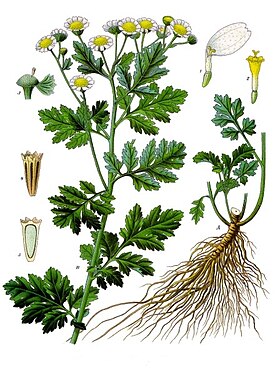Pizhma Devychivya , or Piretrum maiden ( Latin: Tanacétum parthénium ), is a perennial herb of the genus Pizhma of the Astrovye family .
| Tansy maiden |

Tansy girlish. Botanical illustration from the book Köhler's Medizinal-Pflanzen , 1887 |
| Scientific classification |
|---|
| The kingdom : | Green plants |
|
| International Scientific Name |
|---|
Tanacetum parthenium ( L. ) Sch.Bip. , 1844 |
| Synonyms |
|---|
- Aphanostephus pinulensis JMCoult.
- Chamaemelum parthenium (L.) EHLKrause
- Chrysanthemum parthenium (L.) Pers.
- Chrysanthemum parthenium (L.) Bernh.
- Chrysanthemum praealtum Vent.
- Dendranthema parthenium (L.) Des Moul.
- Leucanthemum odoratum Dulac
- Leucanthemum parthenium (L.) Gren. & Godr.
- Matricaria parthenium L.
- Parthenium matricaria Gueldenst.
- Pontia matricaria Bubani
- Pyrethrum buschianum Sosn.
- Pyrethrum demetrii Manden.
- Pyrethrum divaricatum ( Sosn. ) Sosn.
- Pyrethrum glanduliferum Sommier & Levier
- Pyrethrum grossheimii Sosn.
- Pyrethrum sericeum var. divaricatum (Sosn.) Sosn.
- Pyrethrum sevanense Sosn. ex grossh.
- Tanacetum grossheimii (Sosn.) Muradyan [2]
|
|
A common and popular ornamental garden and medicinal plant.
Content
Balkan Peninsula , Asia Minor , Caucasus , Transcaucasia . As a cultivated plant, it is introduced and grown in most countries of Europe and the Mediterranean , as well as in North America and Chile [3] .
A perennial, highly branched plant 50 cm high.
Leaves pinnate-cut or deeply cut, softly pubescent, light or yellow-green.
The inflorescences of the basket are 1.5–3 cm in diameter, in many forms they are terry, gathered in apical inflorescences, white or yellow.
Blossoms in 80-100 days after sowing. Blooms profuse from July to late August.
Seeds are small, rod-shaped, cream-colored, in 1 g contains 4500-5000 pieces. Germination persists for at least three years [4] .
As a medicinal plant tansy maiden is known since ancient times. For therapeutic purposes, dried leaves and other above-ground parts of the plant are used. In folk medicine, tansy is traditionally used for fevers , inflammations , gynecological diseases , psoriasis , toothache , insect bites, rheumatism , asthma, and stomach pains. Feverfew extract is predominantly prescribed to prevent migraine attacks and alleviate the associated symptoms.
Tansy preparations are presented in various forms and means, including in the form of fresh leaves, dried ground leaves, and alcoholic extract. With regard to the safety of tansy, toxicological studies have shown that prolonged prophylactic use of this plant does not affect the frequency of chromosomal aberrations in lymphocytes and the mutagenicity of urine. However, individual reports describe the development of contact dermatitis due to the influence of tansy.
In Europe it has been cultivated in gardens since the Middle Ages [3] .
